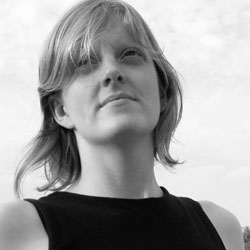If I were to sleep, it would be on an iron bed,
bolted to the floor in a bomb-proof concrete room
with twelve locks on the door.
I wouldn’t ask for a mattress
or decorate. I wouldn’t ask for beautiful.
I’d let the philosophers in,
but not into my bed.
They’d arrive cradling their brass instruments.
I might let them play
but only very softly and only if
they didn’t fight or sing.
If I were to sleep, there wouldn’t be any windows.
There would be a skylight,
but in the middle of the floor.
I’d press my face against the glass
and stare down at other floors upon floors upon floors …
I’d do a sleep dance right on top of the skylight.
It would be a new game.
It would involve amazing feats of sleep contortion.
It would involve letters.
If I were to sleep, I would be spread-eagled across the bed,
and even with the iron struts and screws cutting into my back,
I would protect the metal frame.
I would protect the springs.
Notes on the Poem
Literally and figuratively, something rather perfectly wraps up "Insomnia" and all of the poems in Kate Hall's 2010 Griffin Poetry Prize shortlisted collection The Certainty Dream - the book's charmingly deceptive puzzle of a cover. Take a look ... then take another look:The book cover is so singular and clearly such an important part of the collection that it is mentioned in the judges' citation:
Kate Hall’s book is called The Certainty Dream and it has what appear to be three homemade helicopters on the cover. The helicopters are in fact oil cans lashed to egg beaters and are held together by the good hopes of two tiny humans waving at them from the lower margin of the cover. It is a summary image of Kate Hall’s method and mood.That Rube Goldberg-esque construction on the cover of The Certainty Dream captures well the internal logic of intricate, outrageous dreams, the fevered dreams of an extremely fatigued mind (someone suffering from insomnia, perhaps?) finally dropping into a fitful sleep: "If I were to sleep, there wouldn’t be any windows. There would be a skylight, but in the middle of the floor. I’d press my face against the glass and stare down at other floors upon floors upon floors ..." "If I were to sleep" sounds ruefully hopeful but resignedly hopeless at the same time, doesn't it? And then the desperate sleep aspirant is gazing, in a description that at first blush seems to make sense, at a world turned upside down. She's dreaming, so surely she's finally getting some respite from her sleeplessness. How a book comes to be designed and covered with specific colours, imagery and effects is different in every case. Surely artist David Trautrimas read at least this poem, perhaps also "Dream in Which I Am Separated from Myself", to capture the poems and "Hall’s method and mood" so uncannily.
